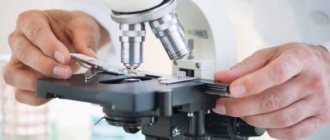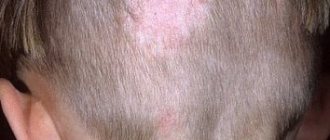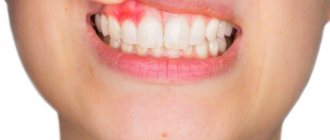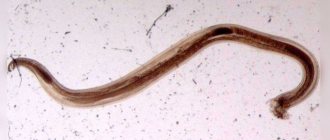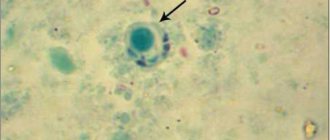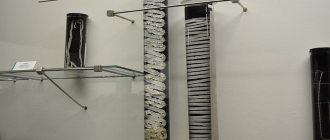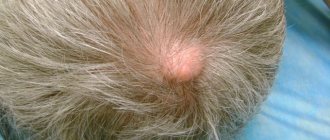Demodectic mange is one of the most unpleasant eye diseases. It is caused by opportunistic parasites, mites of the genus Demodex. In every second person, they live in small numbers on the skin of the face, eyelash follicles and in the sebaceous glands of the eyelid, but when favorable conditions occur, the mites begin to multiply rapidly and cause a disease such as ophthalmodedecosis , causing irritation and discomfort in the eyes.
1
Diagnosis and treatment of demodicosis
2 Diagnosis and treatment of demodicosis
3 Treatment of demodicosis
Symptoms of demodicosis
Demodicosis manifests itself in 2 forms: the skin form of the disease and demodicosis of the eyelids .
With the cutaneous form of demodicosis, inflammation appears on the skin of the face, the chin, cheeks and brow ridges are especially affected. The skin of the chest and back is much less commonly affected. The main symptom of the cutaneous form of demodicosis is inflammation of the sebaceous glands and hair follicles, which leads to the formation of acne, redness of the skin and the formation of crusts.
Symptoms of demodicosis of the eyes may be as follows:
- itching and burning at the base of the eyelashes;
- eyelashes sticking together in the morning;
- rapid eye fatigue;
- dry eye syndrome;
- yellowish mucus in the eyes;
- sensation of a foreign body in the eye.
Symptoms may worsen in the morning, as well as after taking a hot bath, visiting a bathhouse or sauna, or being in the sun.
If such symptoms are detected, you should urgently consult a dermatologist (in the case of the skin form of the disease) or an ophthalmologist (in the case of eye demodicosis): the disease is contagious and quickly spreads to neighboring areas.
1 Diagnosis and treatment of demodicosis
2 Diagnosis and treatment of demodicosis
3 Treatment of demodicosis
What is the diagnosis of eye demodicosis based on?
An experienced ophthalmologist conducts special laboratory tests to identify Demodex mites, and also pays attention to the visible characteristic signs of eye demodicosis:
- redness along the edges of the eyelids;
- pustules between eyelashes;
- sticky eyelashes with a yellowish coating and scales;
- dilated capillaries of the eyelids and retina;
- thinning and frequent loss of eyelashes.
BIBLIOGRAPHY _
Akbulatova L.H. The pathogenic role of the Demodex mite and clinical forms of demodicosis in humans. // Bulletin of Dermatology, 1996, 2, pp. 57-61.
Akilov, O.E., Vlasova I.A., Kazantseva S.V., Features of the immune response in patients with dermatoses complicated by severe infestation of anthropophilic mites of the genus // Immunology. 2002. - No. 1. P.43-47
Ambartsum, AM Treating demodicosis / AM Ambartsum // New pharmacy. 2007. -№7. — P.32-35
Beridze, L.R. Changes in immune parameters in primary and secondary demodicosis of the skin // Georg. Med. News. 2004. - No. 6 - P.43-45
Bobrov V.M. Rosacea of the nose, complicated by demodicosis. Bulletin of Dermatology and Venereology 1994; 4:43-44
Butov, Yu.S., Akilov O.E. Clinical features and issues of classification of demodicosis of the skin // Ros. magazine skin and venereal diseases. 2003. - No. 2. — P.53-58
Vartapetov A.Ya. Follicular demodex in skin pathology. // Abstract report at a scientific-practical conference, Moscow Research Institute of Cosmetology of the Ministry of Health of the RSFSR. M., 1972, pp. 38-39
Vasilyeva M.S., Lange A.B. Iron mite populations in perioral dermatitis and rosacea. M: 2006; 135
Vasilyeva M.S., Shif L.V., Vardoyants S.A., Kanbarova L.I. About some clinical manifestations of demodicosis: New cosmetic preparations and treatment of diseases and cosmetic defects. Sat. scientific works of the hospital named after. Y.M.Sverdlova. L 1970; 45-48
Verkhoglyad I.V. Modern antiparasitic therapy of demodicosis // Clinical. dermatology and venereology. 2006. - No. 4. — P.89-90
Vostroknutova T.M. , Mokronosova M.A., Iron mites and problematic facial skin // Attending physician. -2007. No. 9. — pp. 10-12
Zhsltikova, T.M. Is demodicosis a diagnosis or a symptom? // Medical Bulletin. - 2006. - No. 38. — P. 16
Clinical recommendations, Dermatovenereology /edited by A.A. Kubanova// M.: DEX-Press, 2010.-206-209, 230-233
Kogan B.G., Gorgol V.T. Specificity of Demodex folliculorum and Demodex brevis mites, the causative agents of human demodicosis. // Ukrainian Journal of Dermatology, Venereology, Cosmetology, 2001, 21, pp. 37-41.
Kogan, B.G., Gorgol V.T. Diagnosis of demodicosis // Dermatology. Cosmetology. Sexopathology, - 2008. No. 1-2 (11).- P. 286-287
Koshevenko, Yu.N. Demodicosis pseudo-problem of dermatocosmetology // Ros. magazine skin and venereal diseases. - 2004. - No. 4. — P. 6469
Loshakova, V.I. Demodicosis is an urgent problem of modern dermatocosmetology // Vestn. postgraduate honey. education. — 2001. -№1. - pp. 79-80
Petrosyan E.A., Petrosyan V.A. Treatment of rosacea complicated by demodicosis with blood extracorporeally modified with sodium hypochlorite. Vestn Dermatol 1996;2:42-44.
Polunin G.S., Kasparova E.A., Polunina E.G.: Clinical effectiveness of blepharogels in the prevention and treatment of blepharitis. New in ophthalmology No. 1, 2004, pp. 44-47
Akilov OE, Mumcuoglu KY Immune response in demodicosis. //J Eur Acad Dermatol Venereol., 2004, v.18, N4, p.440-444
Aylesworth R., Vance JC Demodex foliculorum and Demodex brevis in cutaneous biopsies. //J.American Academy of Dermatology, 1982, v. 7, n. 5, p. 583-589
Ayres J, Ayres S (1961) Demodecidosis in the human. Arch Dermatol 83:816–27
Bassiouni SO, Ahmed JA, Younis AL, Ismail MA, Saadawi AN, Bassiouni SO A study on Demodex folliculorum mite density and immune response in patients facial dermatoses. // J. Egypt Soc. Parasitol., 2005, v.35, N3, p.899-910
Forton F., Cermaux M.A., Brasser T. Et al. Demadecosis and rosacea: epidermiology and significance in daily dermatologie practice. J Am Acad Dermatol 2005; 1:74-87
Forton F., Seys B. Density of Demodex follicolorum in rosacea: a case-control study using standardized skin-surface biopsy. // British J. of Dermotology, 1993, v.128, p.650-659
Kligman AM, Christensen MS Demodex folliculorum: Requirements for Understanding Its Role in Human Skin Disease. Journal of Investigative Dermatology. 2011; 131:8–10
Kogan BG, Stepanenko VI, Gorgol VT, Pavlyshin AV Role of Demodex mites and Helicobacter infection in etiopathogenesis of rosacea, demodicoses, perioral dermatitis and acne disease. Eur Acad Dermatol Venerol 2003; 15(3): 165.
Lacey N, Kavanagh K, Tseng SC. Under the lash: Demodex mites in human diseases. Biochem (Lond). 2009; 31(4): 2-6
Nutting WB Pathogenesis associated with hair follicle mites (Acari: Demodicidae) // Acarologia, 1975, V.17, p.493-507
Rodriguez AE, Ferer C, Alio JL Chronic blepharitis and Demodex. //Arch. Soc. Esp. Oftalmol, 2005, v; 80, N11, p. 635-42
Rufli T., Mumcuogly Y. Tile hair follicle mites Demodex folliculorum and Demodex brevis: biology and medical importance // Dermatolog., 1981, p.162
Causes of demodicosis of the eyes
This disease can appear as a result of internal factors:
- decreased immunity after illness;
- chronic microbial and viral diseases;
- the appearance of foci of infection in the body, for example, untreated caries;
- eye refractive diseases;
- hormonal disorders;
- seborrheic dermatitis;
- acne;
- disturbances in the functioning of the nervous and cardiovascular systems;
- diseases of the liver and gastrointestinal tract.
External factors can also trigger the appearance of demodicosis of the eyes:
- previous ophthalmic surgeries;
- dirty, dusty air;
- high air temperature;
- unhealthy lifestyle, alcohol abuse.
Untreated demodicosis can lead to keratitis, blepharoconjunctivitis, blepharitis and visual impairment. A deficiency of tear fluid is dangerous for the development of secondary infection.
Diagnosis of demodectic blepharitis
— Collection of complaints and information about the presence of chronic diseases; — Biomicroscopy—examination of the eyelids and ocular surface with a special device. Upon examination, the condition and quality of the tear film, meibomian gland ducts, and discharge in the eye cavity are determined; -Laboratory diagnostics - bacteriological examination of the microflora of the conjunctival cavity and determination of sensitivity to antibiotics may be required; — Microscopic examination for the presence of mites of the genus Demodex. At the same time, an acarogram is made (counting larvae, eggs and other forms of mites). The presence of a tick serves as an objective diagnostic criterion.
The presence of more than 4 live moving ticks confirms the diagnosis of demodectic blepharitis.
How is demodicosis of the eye transmitted?
Demodectic mange of the eyes can be contracted at home - by sharing hygiene items, towels, bed linen, and cosmetics with the patient.
To prevent re-infection, you need to change your pillowcase and towel (or use paper towels) daily, and throw away contaminated cosmetics.
To treat each eyelid, you must use a separate (new each time) cotton swab.
1 Diagnosis and treatment of demodicosis
2 Diagnosis and treatment of demodicosis
3 Treatment of demodicosis
Risk factors
Risk factors for the development of demodicosis of the eyelids include not only chronic diseases, lack of vitamins, unfavorable environmental and sociocultural conditions, but also the complex anatomical structure of the eyelids. Scales, remnants of cosmetics, as well as unremoved secretions of the meibomian glands accumulate between the eyelashes, which creates favorable conditions for the growth of bacteria and the proliferation of parasites that cause blepharitis or aggravate its course. Clinical manifestations of mite activity will appear in patients with reduced immunity, visual impairment (farsightedness and myopia), metabolic disorders, elderly patients and people with impaired gastrointestinal tract function.
Treatment of demodicosis of the eyes
It should be kept in mind that demodicosis of the eyes is caused by parasites, and the disease will not go away on its own. It must be treated over a long period. If you do not follow all the doctor’s instructions, demodicosis quickly becomes chronic, which is more difficult to treat. The insidiousness of the disease is that after some time the external signs of the disease disappear, but repeated self-infection may occur.
Therefore, treatment of demodicosis is quite long and includes a number of measures, including the following:
- compliance with personal hygiene rules, disinfection of bed linen;
- treating the eyelids with special products, cleaning the skin from crusts and plaque;
- treating the base of the eyelashes with drops or bactericidal gel;
- regular application of medicinal ointment prescribed by a doctor to the eyelids;
- regular massage of the eyelids and removal of discharge along with mites;
- the use of physiotherapeutic methods - magnetic therapy, electrophoresis, etc.;
- following a diet excluding sweets, spicy and salty foods;
- increasing immunity, eliminating foci of chronic infection.
Description of the disease
Demodectic blepharitis is a chronic disease that occurs with periods of exacerbations and remissions. When the edges of the eyelids become inflamed (blepharitis), favorable conditions are created for the life and reproduction of mites of the genus Demodex, which in turn aggravates the clinical course of the disease.
In 1841, the first mentions of a parasite with an interesting name - Demodex - appeared in the literature. Scientists have found it on the skin in acne, as well as in earwax. It was then that the name Demodex was coined (from the Greek Demo - lard, Dex - worm). Only two subtypes have been found on human skin: Demodex folliculorum and Demodexbrevis.
According to modern domestic researchers in the Russian Federation, parasite carriage (i.e. the presence of this mite in the skin) is observed in 100% of cases in patients over 60 years of age and in 50% of younger people.
Diagnostics
Demodicosis on the face and skin is diagnosed by a dermatologist. If the disease is secondary and has developed against the background of the underlying disease, then doctors of other specialties (gastroenterologist, gynecologist, trichologist, endocrinologist, etc.) may be involved for diagnostic and therapeutic purposes. For diagnosis, first of all, visual inspection is used. The doctor evaluates the condition of the skin, eyes and affected areas of the body. In addition, eye biomicroscopy and laboratory examination methods are practiced. The most informative of them are:
- Slit lamp biomicroscopy of the eye is a non-invasive examination aimed at looking for active inflammation. This is an absolutely painless manipulation that does not require special preparation;
- Eyelash test - involves taking freshly removed eyelashes (4 from each eyelid) for further examination under a microscope. Using this method, it is possible to determine the number of parasites (the presence of more than 1 mite on 2-4 eyelashes is pathogenic). This is also a painless procedure, but before it is carried out it is necessary to abandon decorative and skincare cosmetics for several days;
- Biopsy. This is the most informative diagnostic method, but the most traumatic. Diagnosis is carried out under local anesthesia using a tubular knife or scalpel. The taken biomaterial is fixed in a formaldehyde solution for a day and treated with dyes. This makes it possible to fully visualize the gland and adjacent tissues with the pathogenic mite.
Why does demodicosis cause inflammation of the eyelids?
There are meibomian glands on the eyelids. Of these, a special lipid secretion is released into the eye cavity, which is part of tears. It forms a thin film on the surface of the eye and prevents tears from evaporating.
Ticks settle in the ducts of the meibomian glands. They damage their walls, causing blockage of the ducts. The eyes become inflamed, red, they are not sufficiently moisturized, and become dry. In places where the ducts are damaged, scars form and thickenings appear. Ticks behave actively, reproduce, and leave waste products. The carrier of mites reacts sensitively to them, and a severe allergic reaction may occur.
Prevention
To minimize the risk of Demodex infection, it is recommended:
- washing the face with soap and water;
- isolating items from infected people, such as using separate toiletries;
- reducing alcohol consumption and excessive exposure to sunlight.
Additionally, you can carry out morning and evening toileting along the edge of the eyelid using specialized disinfecting gels and lotions containing moisturizing substances that relieve inflammation.
Prevention of demodicosis of the eyelids
Prevention of the disease consists of eliminating risk factors (treatment of chronic diseases, maintaining immunity, optimal intake of vitamins). If you have acne, follow up with a dermatologist to curb the inflammation process.
Preventive hygiene of the eyelids (including washing, warm compresses, massage of the eyelids), the use of a small amount of cosmetics and fatty creams reduces the likelihood of clinical manifestations. There is also modern evidence of the positive effect of using the OMEGA-3 supplement, containing polyunsaturated fatty acids, in the prevention of eyelid inflammation.
It is important to lead a healthy lifestyle and be attentive to your health, and at the first symptoms, immediately seek specialized help. After all, only you yourself are the main indicator of your condition. Love yourself and be healthy!
Demodicosis of the head
Ticks of the genus Demodex are representatives of opportunistic microflora of the skin on the body, including the head. They are present in almost all people on the planet. In everyday life, their activities do not cause visible discomfort; they exist in a mutually beneficial relationship with humans, fighting harmful microorganisms. But when the immune defense drops and unfavorable conditions set in, the parasites begin to multiply uncontrollably, as a result of which their numbers increase greatly, and the vital activity of these parasites becomes noticeable. This situation can result from:
- Hormonal imbalance;
- Long-term use of antibacterial and hormonal medications;
- Poor nutrition;
- Abuse of saunas, steam baths and solariums;
- Using low-quality cosmetics to care for skin and hair (since demodicosis needs to be treated comprehensively, our clinic specialists help patients choose the right and safe care products);
- Failure to comply with simple hygiene rules.
How to eat during treatment?
Now many people do not accept drug therapy and prefer folk remedies. This is an erroneous and ineffective method. Only a qualified doctor can conduct the necessary examination to prescribe proven and safe medications.
But we will give you some nutritional tips. Remember the words of Pythagoras: “Man is what he eats”? Exclude from your menu anything that dilates blood vessels. These products cause blood to rush to the face, which is undesirable if you have demodicosis. Drink coffee less often (especially with sugar), avoid herbs and hot spices. Do not over-salt your food under any circumstances!
During therapy, avoid fatty and smoked foods. Reduce your intake of citrus fruits and soda, all of which cause allergic reactions.
The latest treatment methods
Although demodicosis is easily identified and responds well to treatment, the recovery process is not so quick and can take six months.
The main thing to do when starting therapy is localization of the infection channel. In other words, normalize skin immunity. If metabolism or hormonal levels are disrupted, it is necessary to restore them.
This pathology requires an integrated approach. Therefore, the treating ophthalmologist collects a complete medical history in advance, on the basis of which he prescribes the optimal method of treatment.
Typically, experts suggest the following method of therapy:
- immunomodulatory drugs and vitamin and mineral complexes;
- medications to normalize the functioning of the gastrointestinal tract;
- broad-spectrum antiparasitic agents (used for at least 14 days);
- antihistamines to relieve swelling and irritation;
- external treatment of skin lesions with special compounds;
- eye drops, ointments.
The main rule in treating any disease is to unquestioningly follow the doctor’s recommendations.
Diagnosis of the disease
Establishing an accurate diagnosis does not cause difficulties and does not require preparatory measures. To do this, the patient submits a scraping for demodicosis. The test can be taken in the laboratory of a medical institution at the place of registration, or at a dispensary. But budgetary organizations do not always have the necessary material for the survey.
The eye biomicroscopy procedure involves selecting cilia and eyebrow hairs without damaging the hair follicles, examining them under a microscope, and counting parasites, larvae, and eggs. Their number is normally 0–1; the presence of 3–4 or more microorganisms on 6 eyelashes indicates a deviation.
Before the session, it is not recommended to use cosmetics, creams, or eye drops if the patient resorts to them due to impaired functioning of the visual apparatus.
What is prescribed for demodicosis?
To effectively get rid of an unpleasant illness, the doctor prescribes an impressive list of medications to the patient. The most popular drug is Blefarogel. It is formulated with sulfur to kill arthropods and parasites that live in the sebaceous glandular ducts. It contains hyaluronic acid, which can accelerate skin restoration and increase epidermal protection.
In addition to Blefarogel, the doctor often prescribes Tobramycin and Albucid drops. Okomistin, Physostegmin or Carbohol are also used. This is just a short list of modern drugs used in the treatment of demodicosis.
Skin ointments are considered quite popular. They are used in advanced forms of the disease, when the face is covered with a rash and the lesion has reached the hair follicles. The most common of these drugs are “Rozamet”, “Benzyl benzoate”, “Sulfur ointment”, “Permethrin ointment” and others.
Do not forget that each patient is given prescriptions individually. Do not delay going to the doctor and visit an ophthalmologist at the first signs of illness.
Classification of forms of the disease:
Demodectic mange is classified according to its form:
- Erythematous - the initial form in which the first symptoms appear (swelling of the eyelid skin, redness).
- Pustular - acne and ulcers measuring 0.5 to 2 mm with severe perifollicular inflammation appear on the patient’s skin.
- Mixed.
Demodicosis of the eyelids is a separate form in which the parasite inhabits the meibomian glands - modified sebaceous glands, the mouths of which open at the edges of the eyelids. There are several forms of this disease:
- Asymptomatic carriage.
- Low-symptomatic forms.
- Blepharoconjunctivitis (uncomplicated, complicated).
Demodicosis of the eyelids in humans: what is it, symptoms and treatment
Parasitic diseases are rare in ophthalmology. But more and more often a disease such as demodicosis is being diagnosed. It is caused by mites that live in hair follicles. These parasites can be present on the eyelashes of many people, but their presence does not indicate demodicosis. The disease occurs when parasite activity increases, which can be caused by various factors. At the first symptoms of the disease, it is recommended to consult a doctor, since lack of treatment can lead to eye damage and even irreversible deformation of the eyelid margins.
Demodectic mange of eyebrows
Advanced disease usually takes a more complex form. Demodex begins to affect not only the eyelids and eyelashes, it reaches the forehead, hair and even the neck. In ophthalmology, this condition is described as " demodicosis of the eyebrows ". A dangerous tick moves to the wings of the nose, cheeks, and chin.
A characteristic sign of this pathology is peeling skin, dandruff, tiny wounds on the scalp and rapidly falling out hair. If this disease is suspected, the doctor will need to scrape the eyebrows.
Prevention and treatment of both types of Demodex lesions are almost the same. The difference lies in the patient's health characteristics. These may be diseases for which the drug prescribed by a specialist is contraindicated or undesirable. If there is damage to the hair and scalp, the doctor recommends consulting a trichologist who will help maintain the thickness of your hairstyle.
Demodicosis - drugs for treatment
Today, finding effective remedies for demodicosis will not be a problem. The specialists of our medical center select medications in the optimal form on an individual basis, thereby speeding up the healing process. The most popular and effective remedies are described below.
Soap
- Demolan Forte and Stop Demodex demodex.by are especially popular among patients. For demodicosis of the eyelids, the treatment regimen often includes these drugs, as they show excellent results due to the presence in the composition:
- Glycerin - absorbs moisture, holding it on the skin. This helps prevent drying, promotes hydration and improves elasticity;
- Octopirox is an antimicrobial component that inhibits the activity of ticks. It gently exfoliates the top layer of the epidermis, normalizing the process of formation of new cells;
- Propylene glycol - helps normalize microflora, moisturizes the stratum corneum;
- Diazolidinyl urea - provides an antimicrobial effect.
Lotion
Demolan Forte and Stop Demodex lotions are prescribed for constant facial skin care and for cleansing damaged skin areas (even demodicosis on the back) before using the gel. They are often used for eyelid hygiene (for blepharitis), as they deeply cleanse the pores and facilitate the penetration of the active substances of subsequent medications. With their help, it is possible to soften the epidermis and normalize fat metabolism without resorting to tapping the skin. As a result of their regular use, mites are deprived of their nutrient medium, and the tissue is regenerated at an accelerated rate without the formation of scars.
Balm
Therapeutic and prophylactic balm Stop Demodex significantly increases the effectiveness of the main therapy. With its regular use, a visible therapeutic effect is observed after 2-3 days. It has the following properties:
- Anti-inflammatory and bactericidal;
- Moisturizing the skin;
- Promotes rapid tissue regeneration and healing;
- Improves local metabolism;
- Penetrates the cell membrane of the epidermis, replenishes the lack of microelements.
Eye gel
When diagnosing eye demodex, it is strongly recommended to use Demolan Forte and Stop Demodex gels. The presence of peppermint extract in the composition guarantees local anesthesia and inhibition of inflammation. They have a calming and refreshing effect, due to which the patient’s well-being noticeably improves. The presence of metronidazole provides effective antiprotozoal and antibacterial effects, while hyaluronic acid helps improve skin elasticity and firmness. These demodicosis preparations are perfectly absorbed, do not clog pores and do not disrupt cellular metabolism. They accelerate tissue regeneration and prevent the formation of scars.
Cream
An effective cream for demodicosis, Stop Demodex, with constant use, makes it possible to stabilize the normal secretion of the sebaceous glands, restore the skin microflora, eliminate the uncontrolled proliferation of parasites of the Demodex genus and noticeably cleanse the skin from foci of inflammation. It does not contain antibiotics, perfectly nourishes, increases tissue firmness and elasticity, and does not have a comedogenic effect.
Mask
For demodicosis infection, it is strongly recommended to buy a Stop Demodex treatment mask. It contains the active Cutipure complex and white clay, which promotes deep cleansing of pores and reduces the proliferation of pathogenic mites. It has anti-inflammatory, antibacterial and keratolytic effects. Its use allows you to normalize sebum production, tone the skin, improve metabolic processes in cells and accelerate tissue regeneration. Moreover, with its help it is possible to remove toxic molecules.
Shampoo
Using Stop Demodex shampoo for demodicosis of the head, you can significantly reduce itching, eliminate dandruff and stop the active reproduction of parasites. It has a strong anti-inflammatory and regenerating effect, fights mites and helps eliminate the consequences of the disease. Its effect is aimed at preventing ticks from sucking nutrients, disrupting their DNA replication and protein synthesis in the cell. The drug inhibits tissue respiration, which is vital for parasitic life.
Demodicosis in children
- In childhood, this pathology rarely develops (due to the low activity of the sebaceous glands), but its course is much more complicated than in adults. As a rule, in children this disease is chronic, and relapses occur in the off-season. The main signs of the problem are:
- Swelling of the eyelids;
- Loss of eyelashes and hair;
- Severe eye fatigue;
- The appearance of spots on the skin;
- Itching, worse at night and on contact with water;
- Decreased appetite, moody behavior, decreased physical activity;
- Pain in the eyes.
The treatment regimen for democosis of the face and other parts of the body in children is practically the same as therapy for adults. It also includes diet, medication and rehabilitation aimed at healing the tissue and preventing scarring. The fundamental difference in the treatment method is only the dosage of medications, which will be lower in childhood.
Skin demodicosis
The transmission route is contact or contact-household. Can be transmitted through contaminated clothing, bedding, contaminated hands and more. Demodex is distinguished by its survivability under comfortable conditions that correspond to the daily life of most people. The parasite remains viable at a temperature of 17-20°C for 10 days or more, and in an aquatic environment at a temperature of 12-18°C for 3 days. When water is heated to 50° C, the microorganism dies within one minute, and at low temperatures it dies immediately.
To date, there is no single theory explaining the etiology of the development of the inflammatory process and the active reproduction of mites. But there are several predisposing factors that can provoke these processes:
- Excessive sebum production;
- Improper skin care, abuse of cosmetics (especially low quality);
- Long-term use of external corticosteroids;
- Poor nutrition (abuse of sugar, soda, spicy foods, coffee, alcoholic drinks);
- Concomitant gastrointestinal diseases;
- Reduced immunity;
- Hormonal imbalance, excess weight;
- Psychological problems, frequent stress.
3.Diagnosis of the disease
After a visual examination and conversation with the patient, the dermatologist prescribes a microscopic examination
.
Material for analysis is taken by scraping the epidermis from the affected areas of the skin. It is also recommended to analyze eyelashes
taken from different parts of the eyes. Express analysis makes it possible to get instant results. During the study, adult ticks, their eggs and shed chitinous shells are discovered. In order for the dermatologist to see a complete picture of the density of mite colonization of the skin, it is recommended not to wash your face for 24 hours before the examination. What is important for making a diagnosis in this case is not the fact of detecting a tick in itself, but the number and activity of the parasite, as evidenced by the number of larvae and eggs.
About our clinic Chistye Prudy metro station Medintercom page!
